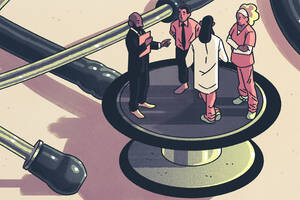If a company makes purchases from its suppliers more unpredictably than it sells to its customers, it is said to “bullwhip.” Bullwhips can cause problems in the supply chain because it may be difficult for suppliers to adjust production in response to the changeable demand.
Robert Bray, an assistant professor of managerial economics and decision sciences at the Kellogg School, explains the bullwhip effect using a bakery as an example. A baker sells three types of cakes: wedding cakes, personalized cakes, and non-personalized cakes. Non-personalized cakes can be bought off the shelf with no advance notice. However, the baker requires personalized cakes to be ordered at least a week in advance and wedding cakes to be ordered at least a month in advance. Assume the baker buys all its supplies, such as flour, sugar, and butter, from a single supplier. The total bullwhip effect, then, is measured as the difference between the variability in total orders (e.g., all of the ingredients bought from the supplier) and the variability in total sales (e.g., the sales of all cakes to customers).
“Up until now,” says Bray, “anyone who has considered the bullwhip effect has only considered this total bullwhip measure. However, we argue that lumping all cakes together ignores valuable information, as the different cakes have different information lead times, and hence different operational implications. We can’t properly mitigate the bullwhip without knowing which information lead time it stems from.”
Deconstructing the Bullwhip
Bray explains that bullwhipping occurs because the retailer acts as an amplifier of demand. For example, if a retailer sells beer, he might have a usual practice of keeping 100 six-packs in stock. Each day, he orders enough beer from the wholesaler to bring his inventory up to 100 six-packs. If he usually sells 10 six-packs a day, he normally orders 10 six-packs from the supplier. However, if one day he sells 50 six-packs, the retailer might think, “Beer is really selling right now, I’d better stock up,” and order 75 six packs. In this way, the increased demand at the retail level of 50 six-packs is “amplified” up the supply chain to 75 six-packs.
The effect works in both directions. If one day the retailer sells only two six-packs, he may not restock at all, thinking, “This may be a slow time for beer sales.” In this case the decreased demand has been “amplified” from two at the retail level to zero up the supply chain.
While a student at Stanford University, Bray worked with Haim Mendelson, a professor of management, to deconstruct the total bullwhip according to information lead time. They classified information learned with less than one quarter’s notice as short information lead time, information learned with at least three quarters of notice as long information lead time, and information learned with notice between these extremes of time as medium information lead time.
The demand signals that companies received with more than three quarters of notice accounted for 30% of the bullwhip.
Bray and Mendelson examined firm-level data from 1974 to 2008 in a sample of 4,689 public U.S. companies, estimating the entire distribution of company bullwhips rather than just their industry-level means. They found that about two-thirds of companies in the sample experienced bullwhip amplifications of demand variability. The mean quarterly standard deviation of upstream orders exceeded that of demand by $20 million.
Their research showed that the demand signals that companies received with more than three quarters of notice accounted for 30% of the bullwhip. However, 51% of the time, firms received less than one quarter’s notice. Naturally, the shorter the lead time, the harder it is to deal with the effect. In addition, short-lead-time bullwhips cost more, Bray and Mendelson write, “as short-notice order revisions require suppliers to produce hastily, in a helter-skelter fashion.”
Another important finding from their research is that seasonal demand is not bullwhipped. In fact, the opposite occurs, and seasonal variations in demand are “smoothed” at the retail level. For example, retailers know that in the last few weeks before Christmas, they will sell more items than at other times of the year. They do not however wait and order all of the additional items just prior to the time of anticipated increased demand. Instead, they increase their inventories by a smaller, more consistent amount over several months. In this way, demand at the production level is more even than demand at the retail level.
Fixing the Bullwhip
The researchers propose three strategies for mitigating the bullwhip effect: information sharing, increasing agility, and fixing orders.
“Suppliers need time to act, so information sharing better mitigates long-lead-time bullwhips, rather than short-lead-time ones,” Bray explains. “On the other hand, order fixing can address short-lead-time bullwhips, but not long-lead-time ones—a firm can commit orders for the next quarter, but not the next year.”
He notes that in his bakery example, bullwhipping wedding cakes would do very little damage because the supplier has a whole month to respond to them. However, bullwhipping non-personalized cakes would be very bad, as that would constitute a last-minute sales surprise.
Bray and Mendelson report a real-world example of how one firm addressed the bullwhip effect, using a multifaceted strategy. Beginning in 2000, Caterpillar Inc. initiated a “supply chain makeover” to address concerns about the potential disruptions that could come with an inventory bullwhip. To address bullwhips with a long lead time, Caterpillar began conveying sales and business data internally to its production design department and externally to its suppliers. It dealt with bullwhips that have medium information time by requiring each of its suppliers to have a detailed written plan for each part they produce, explaining how the supplier would respond to the bullwhip. To address short-lead-time bullwhips, Caterpillar promised its suppliers that it would not change an order it had placed for three months. These changes reduced the bullwhip effect by 95 percent.
It may be that other firms are learning how to reduce the bullwhip effect. Bray and Mendelson determined that, during the period from 1995 to 2008, the average bullwhip experienced by the companies in their sample fell by one-third when compared to the period from 1974 to 1994.
“To effectively address the bullwhip effect, you have to understand it,” Bray concludes. In their paper, he and Mendelson observe that “developing a full understanding of the bullwhip effect will require comprehensive efforts by multiple researchers.” They propose several approaches for future researchers, including estimating bullwhips across supply chains and using actual data on order forecasts.
Bray, Robert L., and Haim Mendelson. 2012. “Information Transmission and the Bullwhip Effect: An Empirical Investigation.” Management Science 58(5): 860–875.


